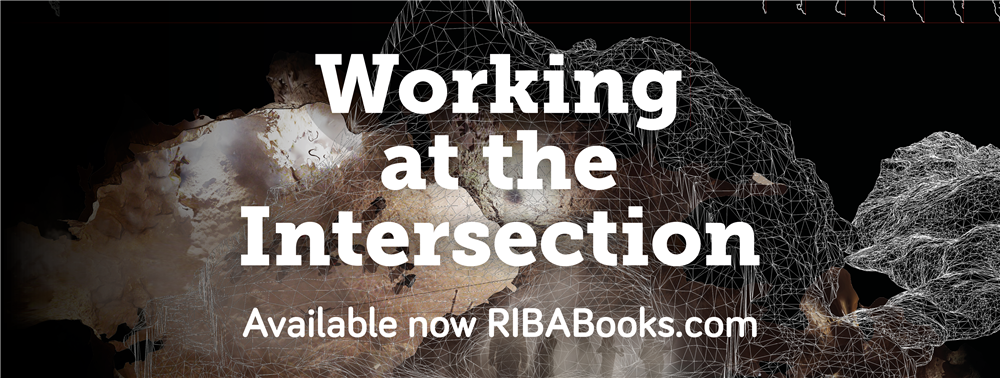‘When intersectionality is understood as a subset of identity politics, the ideological conflicts can seem distracting from more pressing global issues, such as the nested crises we call climate change and the radical new paradigms such crises require.’[1]
V. Mitch McEwen

Post-apocalyptic visions of the future conceive an architecture in ruins. Here, the ‘forest floor’ is moribund. However, in the ‘Binary-Free Zone’, it is alive and fecund – ripe for reproduction. Credit: Harriet Harriss and Severn Eaton.
Functionally extinct koalas. Starving polar bears. Ecosystem collapse. Mass species die-off. Rapid desertification. Multi-dimensional flood risk. Arctic sea ice decline. Ocean acidification. Extreme weather mortalities. Speciesism. Climate feminism. Environmental racism. While these terms are becoming increasingly familiar, the sum of their meaning and impact is not.
You do not need to own a naughty yet loving dog, binge on TV shows about octopus educators nor cheer on the interspecies adoptions that are routinely ranked among the most-watched YouTube videos to understand that humans are not the only creatures capable of empathy. Compassion, justice and ethics are elevated as virtues we have been encouraged to associate with the most altruistic aspects of our humanity, as many of the animal rights and ecological organisations evidence through how they choose to identify – Compassionin World Farming, Greenpeace, PETA(People for the Ethical Treatment of Animals), Union of Concerned Scientists, Earth Alliance, Earth Justice, Friends of the Earth, to name only a few – reinforcing the notion that caring for others – other humans or other species – is required in order to at least acknowledge, if not react to, their suffering.

Pollinators Pavilion at Old Mud Creek Farm, Hudson, NY, 2020 by Harrison Atelier. The form is intended to recall a spiky grain of pollen and a bee’s bristling compound eye, highlighting the manner in which bringing a species into greater visibility may generate greater ethical regard. Credit: Harrison Atelier.
Until relatively recently animal suffering, human suffering and climate collapse were studied separately, thanks to systems of partitioning knowledge into epistemologies (knowledge frameworks) and disciplines. As a direct consequence, policy responses have been inclined to speak to each ‘problem’ individually, but not collectively, or intersectionally. Instead, the many different struggles taking place are not challenged to compete, clash or cancel but, when combined, to amplify. Whether you are a koala burning alive in an Australian bushfire,[2] a farmer starving to death in Madagascar[3] or a 60-year-old Black woman in Brooklyn dying in a heatwave,[4] intersectionality explains why these experiences of climate collapse are not only related, but statistically likely to be more acute than if you were a koala in a city zoo, a farmer in Canada or a white woman living at the gentrified end of the same block in Brooklyn, but with the means to afford air-conditioning.
Interactions involving sexism, racism, classism, homophobia, isolation and environmental catastrophe are entirely interdependent. The solution to one cannot be found without confronting the other. We must expose blinkered perspectives in education and professional practice, and set the table for a more inclusive engagement of the role of architecture in a global environment circumscribed by pandemic, climate change and conservative politics.
[1] V Mitch McEwen, ‘A brief architectural history of intersectionality’, Working at the Intersection – Architecture After the Anthropocene, Harriet Harriss and Naomi House, eds., London, RIBA Publishing, 2022
[2] ‘Hundreds of koalas feared burned alive in out-of-control bushfire near Port Macquarie’, The Guardian, 30 October 2019, https://www.theguardian.com/australia-news/2019/oct/30/hundreds-of-koalas-feared-burned-alive-in-out-of-control-bushfire-near-port-macquarie.
[3] Kaamil Ahmed and Rivonala Razafison, ‘At least 1m people facing starvation as Madagascar’s drought worsens’, The Guardian, 10 May 2021, https://www.theguardian.com/global-development/2021/may/10/at-least-1m-people-facing-starvation-madagascar-drought-worsens.
[4] Ese Olumhense and Clifford Michel, ‘Looking for relief as summer heat wave hits black and brown neighborhoods hardest’, The City, 15 September 2021, https://www.thecity.nyc/health/2020/7/29/21347387/new-york-city-summer-heat-wave-black-neighborhoods-pandemic.

